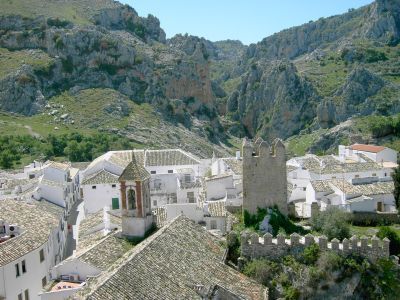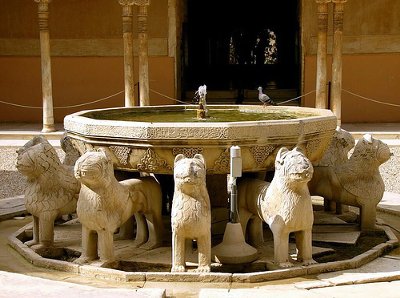I had a choice, either damage myself or the car. The car was on hire and therefore my responsibility, whereas I had travel insurance. I avoided the potholes and drove on the compacted rocks which formed the road's centre. This set up a terrific vibration which loosened my dental fillings. I tried to check them in the rear-view-mirror which was oscillating through 360'. Catapulted Stones from the wheels of passing vehicles were modifying the car's body-work. I had a head-ache! I was sure the whole thing would disintegrate leaving me sat on the bare chassis grimly clutching the steering wheel.
Since leaving the Carretera a Palma Del Rio, the local roads were appalling. I had the impression that some belligerent howitzer battery had just shelled them.
I was to spend the night in a house a few kilometres west of Córdoba. To say it was a hovel is perhaps unfair but it certainly came close. I must stop being so trusting when I book accommodation. Mosquitoes fed on my bodily fluids and howling dogs deprived me of my much needed slumber. The gas cylinder looked to be in a bad state so like a fool I turned it off. As I gave up smoking ten years ago I had no way of lighting it in the morning. I had a cold shower, no coffee and left the house in a foul mood.
The purpose of my enterprise was to follow the Route of the Caliphs, from Córdoba to Granada. I was to start my expedition at Madinat al-Zahra, built on El Cerro de la Novia, The Bride's Hill. Abd al-Rahman III founded the immense complex in AD936. Moorish Spain's infrastructure, its organization and control came from here. I hope their highways department was more efficient than their successors.
I felt at ease amongst the ruins. It wasn't that I wanted to move through the once wonderful buildings in long flowing robes like some moronic Lawrence of Arabia. I had studied archaeology at the University of Exeter and have spent many happy hours on digs. I find I can associate with the ancients, picturing their shadowy figures flitting through their world of long ago. It could have of course be a ploy to forget the present and the reality it represents.
Only a small area of the complex has undergone excavation revealing fine stucco work and the remains of marble columns. Madinat al-Zahra is on three terraces with the highest accommodating the administrative zone. The middle terrace had the gardens, orchards and the all important pools. This area would have been a haven of serenity with water flowing in convoluted channels to irrigate, cool and soothe. The lowest platform housed the military and the general mosque.
 Driving through Córdoba in the rush-hour is not a pleasant experience. If the Caliph had to do it, I am sure he would have found an alternative route. It was horrendous! I finally found the N432 and headed east toward the Sierra Subbètica and the Hotel Zuhayra in Zuheros. This would locate me roughly halfway between Córdoba and Granada.
Driving through Córdoba in the rush-hour is not a pleasant experience. If the Caliph had to do it, I am sure he would have found an alternative route. It was horrendous! I finally found the N432 and headed east toward the Sierra Subbètica and the Hotel Zuhayra in Zuheros. This would locate me roughly halfway between Córdoba and Granada.
My hire-car was in a bit of a state. Freshly dented from the airborne rocks of yesterday. I wondered what unseen damage had been done.
My understanding of mechanics is something akin to Albert Einstein's practical experience of surfing. I once had an old Fiesta which was always failing to start. A friend of mine said the fault was with the distributor. I was all for going around to the Ford dealership and demanding to know why they had sabotaged my car.
The Route of the Caliphs follows the line of fortified towns from the Guadlaquivir Valley towards the fertile plains east of Granada. These citadels formed the first phase of a ninth century defence in depth strategy. Zuheros is a prime example of one of these towns. It clings to the side of the Sierra Subbètica, the castle dominating the town. Erected from within the natural contours of the surrounding rock giving the appearance of complete assimilation with it.
I arrived in Zuheros in the mid-afternoon. It had been three years since I was last here and I felt as if I were coming home. Nothing appeared to have changed, it was very reassuring. The Hotel Zuhayra had the same relaxed cool atmosphere and the attentive staff were familiar faces. I was soon relaxing in a hot bath, soothed by the sounds from the village. People were just emerging from the heat of the afternoon.
I took dinner in the comedor of the Bar Los Palancos. A revuelto de colleja, lamb's lettuce cooked with scrambled egg ham and prawns, washed down with the opaque fino en rama. The meal was delicious. I slept soundly with a full stomach, a glow from the fino and no voracious mosquitoes or vocal dogs to bother me. Tomorrow I was back on the N432 to Granada and the Alhambra.
I left the hotel just before dawn, my entry time for the Nasrid Palaces was 11 to 11:30. The distance was 114 kilometres. I had built in enough time to cater for any eventuality. Getting lost, changing a wheel, abduction by badly informed guerrillas or for any other turn of events that appealed to my tiny mind. As it turned out the road was good, the signposts informative and I reached Granada with time to spare.
The Alhambra complex sits on the Sabika Hill overlooking Granada with the snow covered peaks of the Sierra Nevada behind. A convoluted site consisting of three distinct areas, the Alcazaba, the Nasrid Palaces and the Generalife all arranged with military precision. The Alhambra, we recognise today started with Al-Ahmar the founder of the Nasrid dynasty. Later he moved his affairs from the fortress at Albayzín some time after 1232.
It was the last stronghold of the Muslims in Spain falling to the Christian forces on the 2nd of January 1492. As the Moorish King Boabdil left the city his Mother reputedly said "You cry like a woman for the kingdom that you could not defend like a man". The lady wasn't happy.
 Was I impressed by the Alhambra? Certainly the very clever use of flowing water in the Generalife, cools and animates the gardens enhancing their inherent intimacy. The
Was I impressed by the Alhambra? Certainly the very clever use of flowing water in the Generalife, cools and animates the gardens enhancing their inherent intimacy. The
Nasrid Palaces has some intricate carpentry, tile and stucco work while the immense towers of the Alcazaba offer spectacular views of Granada.
My most enduring memory of Alhambra wasn't its architecture or the immensity of its scale, but the birds, small birds that have adopted the place. Swallows and sparrows, circling the courtyards and towers bring the whole site to life. It is almost as if they were willing participants in the spectacle which is the Alhambra.
I once more found myself in the familiar surroundings of the Hotel Zuhayra reflecting on my day in Granada. Tomorrow it is back to Málaga, the airport and Bristol. I had visited other villages along the Route of the Caliphs, Priego de Córdoba, Lucena, Luque, Iznája and others. These white walled villages are the essence of southern Spain. They show there is another way of life, a quieter, slower, more understanding way.
The drive to Málaga will be the longest of the trip, I dare not look back.